Analyzing Social Media's Impact on Business: A Detailed Report
VerifiedAdded on 2020/02/18
|66
|15905
|84
Report
AI Summary
This report examines the multifaceted effects of social media on businesses, providing a comprehensive analysis of its impact. The study explores how social media platforms have revolutionized marketing, brand recognition, and customer engagement, as well as the shift from traditional business models. The research utilizes a qualitative approach, incorporating case studies and document analysis to assess the benefits and challenges for businesses of all sizes. Key findings include the breakdown of geographical and cultural barriers, the role of social media in enhancing communication, and the cost-effectiveness of online promotion. The report emphasizes the necessity of social media presence for contemporary organizations, highlighting its power in understanding consumer needs and shaping future business trends. Furthermore, the study includes an introduction, literature review, methodology, findings, discussion, and conclusion, offering recommendations for leveraging social media effectively.
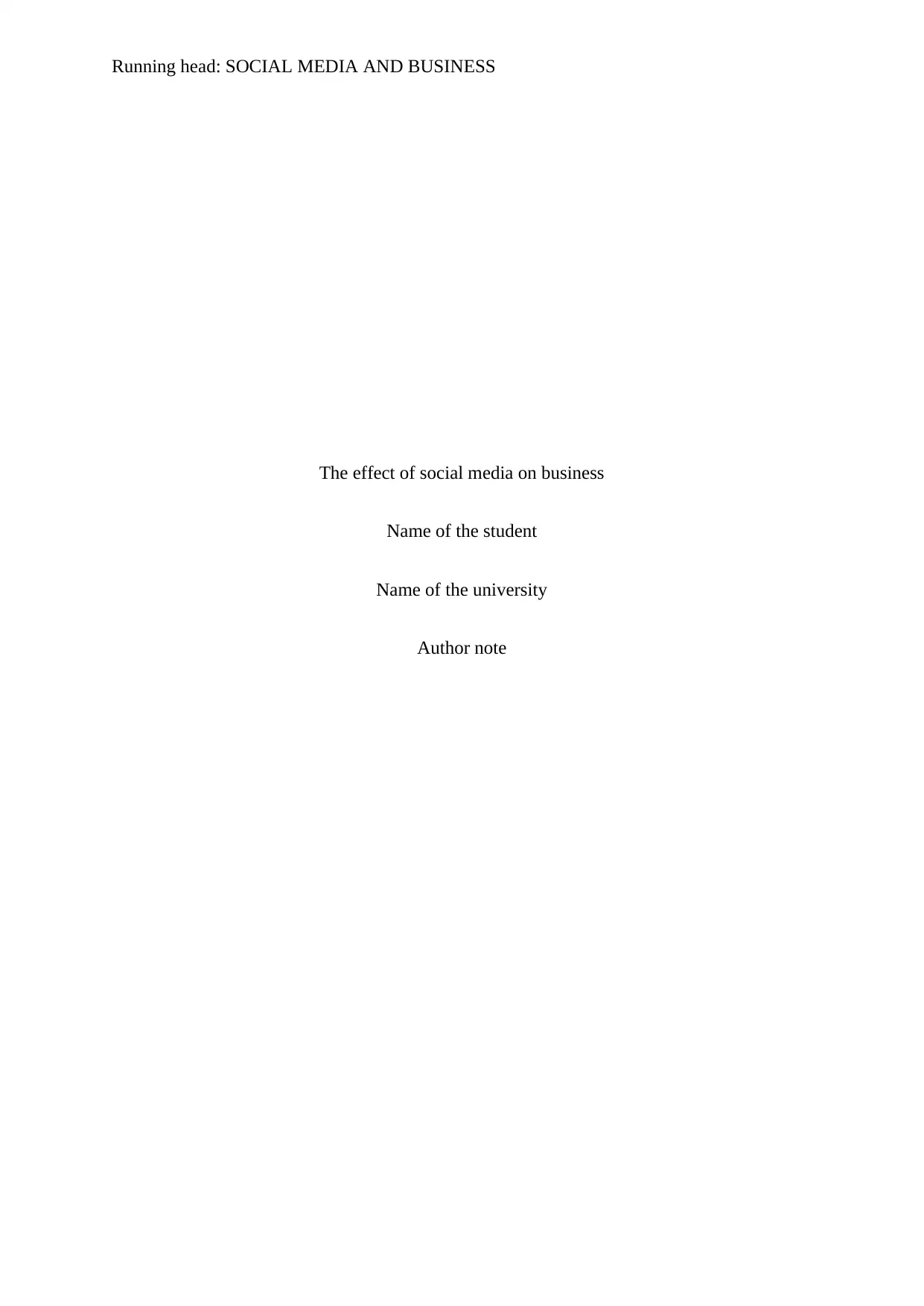
Running head: SOCIAL MEDIA AND BUSINESS
The effect of social media on business
Name of the student
Name of the university
Author note
The effect of social media on business
Name of the student
Name of the university
Author note
Paraphrase This Document
Need a fresh take? Get an instant paraphrase of this document with our AI Paraphraser
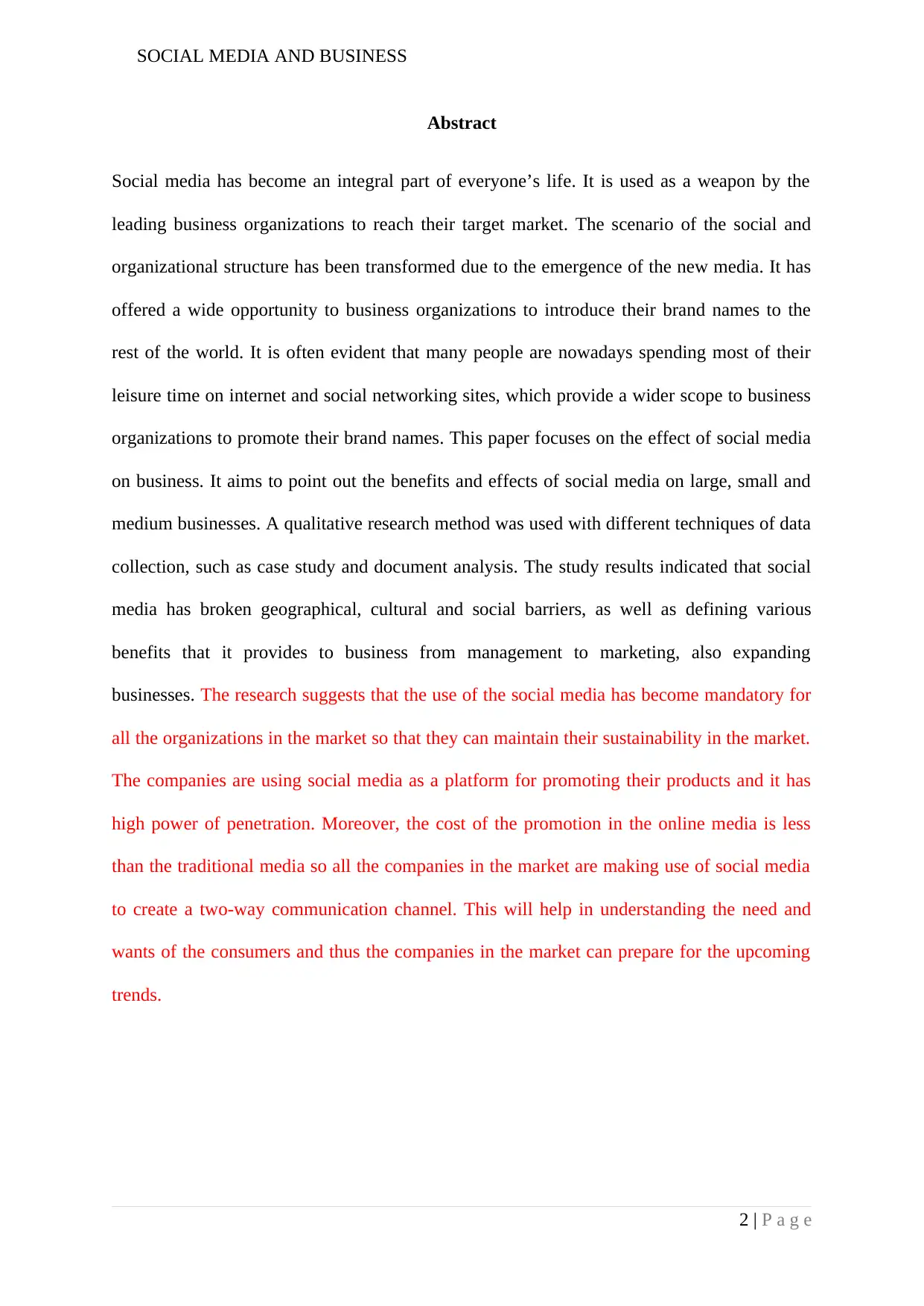
SOCIAL MEDIA AND BUSINESS
Abstract
Social media has become an integral part of everyone’s life. It is used as a weapon by the
leading business organizations to reach their target market. The scenario of the social and
organizational structure has been transformed due to the emergence of the new media. It has
offered a wide opportunity to business organizations to introduce their brand names to the
rest of the world. It is often evident that many people are nowadays spending most of their
leisure time on internet and social networking sites, which provide a wider scope to business
organizations to promote their brand names. This paper focuses on the effect of social media
on business. It aims to point out the benefits and effects of social media on large, small and
medium businesses. A qualitative research method was used with different techniques of data
collection, such as case study and document analysis. The study results indicated that social
media has broken geographical, cultural and social barriers, as well as defining various
benefits that it provides to business from management to marketing, also expanding
businesses. The research suggests that the use of the social media has become mandatory for
all the organizations in the market so that they can maintain their sustainability in the market.
The companies are using social media as a platform for promoting their products and it has
high power of penetration. Moreover, the cost of the promotion in the online media is less
than the traditional media so all the companies in the market are making use of social media
to create a two-way communication channel. This will help in understanding the need and
wants of the consumers and thus the companies in the market can prepare for the upcoming
trends.
2 | P a g e
Abstract
Social media has become an integral part of everyone’s life. It is used as a weapon by the
leading business organizations to reach their target market. The scenario of the social and
organizational structure has been transformed due to the emergence of the new media. It has
offered a wide opportunity to business organizations to introduce their brand names to the
rest of the world. It is often evident that many people are nowadays spending most of their
leisure time on internet and social networking sites, which provide a wider scope to business
organizations to promote their brand names. This paper focuses on the effect of social media
on business. It aims to point out the benefits and effects of social media on large, small and
medium businesses. A qualitative research method was used with different techniques of data
collection, such as case study and document analysis. The study results indicated that social
media has broken geographical, cultural and social barriers, as well as defining various
benefits that it provides to business from management to marketing, also expanding
businesses. The research suggests that the use of the social media has become mandatory for
all the organizations in the market so that they can maintain their sustainability in the market.
The companies are using social media as a platform for promoting their products and it has
high power of penetration. Moreover, the cost of the promotion in the online media is less
than the traditional media so all the companies in the market are making use of social media
to create a two-way communication channel. This will help in understanding the need and
wants of the consumers and thus the companies in the market can prepare for the upcoming
trends.
2 | P a g e

SOCIAL MEDIA AND BUSINESS
Acknowledgements
First of all, I thank Allah for enriching me with knowledge, wellbeing and tolerance to finish
this work. Secondary, I would like to acknowledge my family for all their financial and
emotional support throughout my academic life in the UK. I expressly extend this gratitude to
my Dad and my Mom always believing that I could be successful, as it motivated me to
accomplish my objectives.
My brothers and Fiancé were as well concerned with my wellbeing and supported me in
every way possible; also my Saudi friends.
My greatest appreciation to my supervisor; he played a great role in this achievement due to
his constant guidance and motivation in such a professional way that I can confidently say
that it would be impossible to finish this piece of work without his presence.
3 | P a g e
Acknowledgements
First of all, I thank Allah for enriching me with knowledge, wellbeing and tolerance to finish
this work. Secondary, I would like to acknowledge my family for all their financial and
emotional support throughout my academic life in the UK. I expressly extend this gratitude to
my Dad and my Mom always believing that I could be successful, as it motivated me to
accomplish my objectives.
My brothers and Fiancé were as well concerned with my wellbeing and supported me in
every way possible; also my Saudi friends.
My greatest appreciation to my supervisor; he played a great role in this achievement due to
his constant guidance and motivation in such a professional way that I can confidently say
that it would be impossible to finish this piece of work without his presence.
3 | P a g e
⊘ This is a preview!⊘
Do you want full access?
Subscribe today to unlock all pages.

Trusted by 1+ million students worldwide
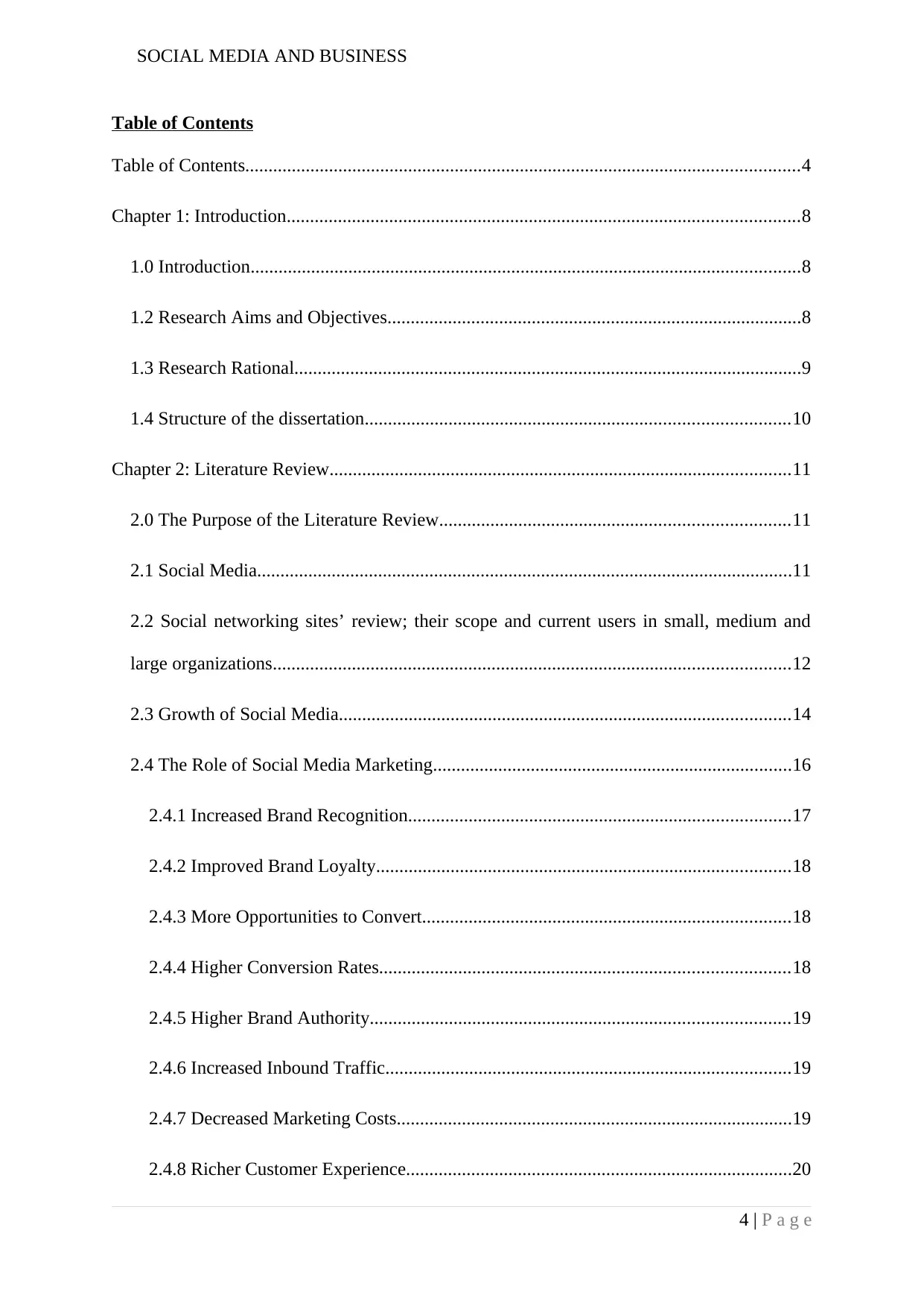
SOCIAL MEDIA AND BUSINESS
Table of Contents
Table of Contents.......................................................................................................................4
Chapter 1: Introduction..............................................................................................................8
1.0 Introduction......................................................................................................................8
1.2 Research Aims and Objectives.........................................................................................8
1.3 Research Rational.............................................................................................................9
1.4 Structure of the dissertation...........................................................................................10
Chapter 2: Literature Review...................................................................................................11
2.0 The Purpose of the Literature Review...........................................................................11
2.1 Social Media...................................................................................................................11
2.2 Social networking sites’ review; their scope and current users in small, medium and
large organizations...............................................................................................................12
2.3 Growth of Social Media.................................................................................................14
2.4 The Role of Social Media Marketing.............................................................................16
2.4.1 Increased Brand Recognition..................................................................................17
2.4.2 Improved Brand Loyalty.........................................................................................18
2.4.3 More Opportunities to Convert...............................................................................18
2.4.4 Higher Conversion Rates........................................................................................18
2.4.5 Higher Brand Authority..........................................................................................19
2.4.6 Increased Inbound Traffic.......................................................................................19
2.4.7 Decreased Marketing Costs.....................................................................................19
2.4.8 Richer Customer Experience...................................................................................20
4 | P a g e
Table of Contents
Table of Contents.......................................................................................................................4
Chapter 1: Introduction..............................................................................................................8
1.0 Introduction......................................................................................................................8
1.2 Research Aims and Objectives.........................................................................................8
1.3 Research Rational.............................................................................................................9
1.4 Structure of the dissertation...........................................................................................10
Chapter 2: Literature Review...................................................................................................11
2.0 The Purpose of the Literature Review...........................................................................11
2.1 Social Media...................................................................................................................11
2.2 Social networking sites’ review; their scope and current users in small, medium and
large organizations...............................................................................................................12
2.3 Growth of Social Media.................................................................................................14
2.4 The Role of Social Media Marketing.............................................................................16
2.4.1 Increased Brand Recognition..................................................................................17
2.4.2 Improved Brand Loyalty.........................................................................................18
2.4.3 More Opportunities to Convert...............................................................................18
2.4.4 Higher Conversion Rates........................................................................................18
2.4.5 Higher Brand Authority..........................................................................................19
2.4.6 Increased Inbound Traffic.......................................................................................19
2.4.7 Decreased Marketing Costs.....................................................................................19
2.4.8 Richer Customer Experience...................................................................................20
4 | P a g e
Paraphrase This Document
Need a fresh take? Get an instant paraphrase of this document with our AI Paraphraser
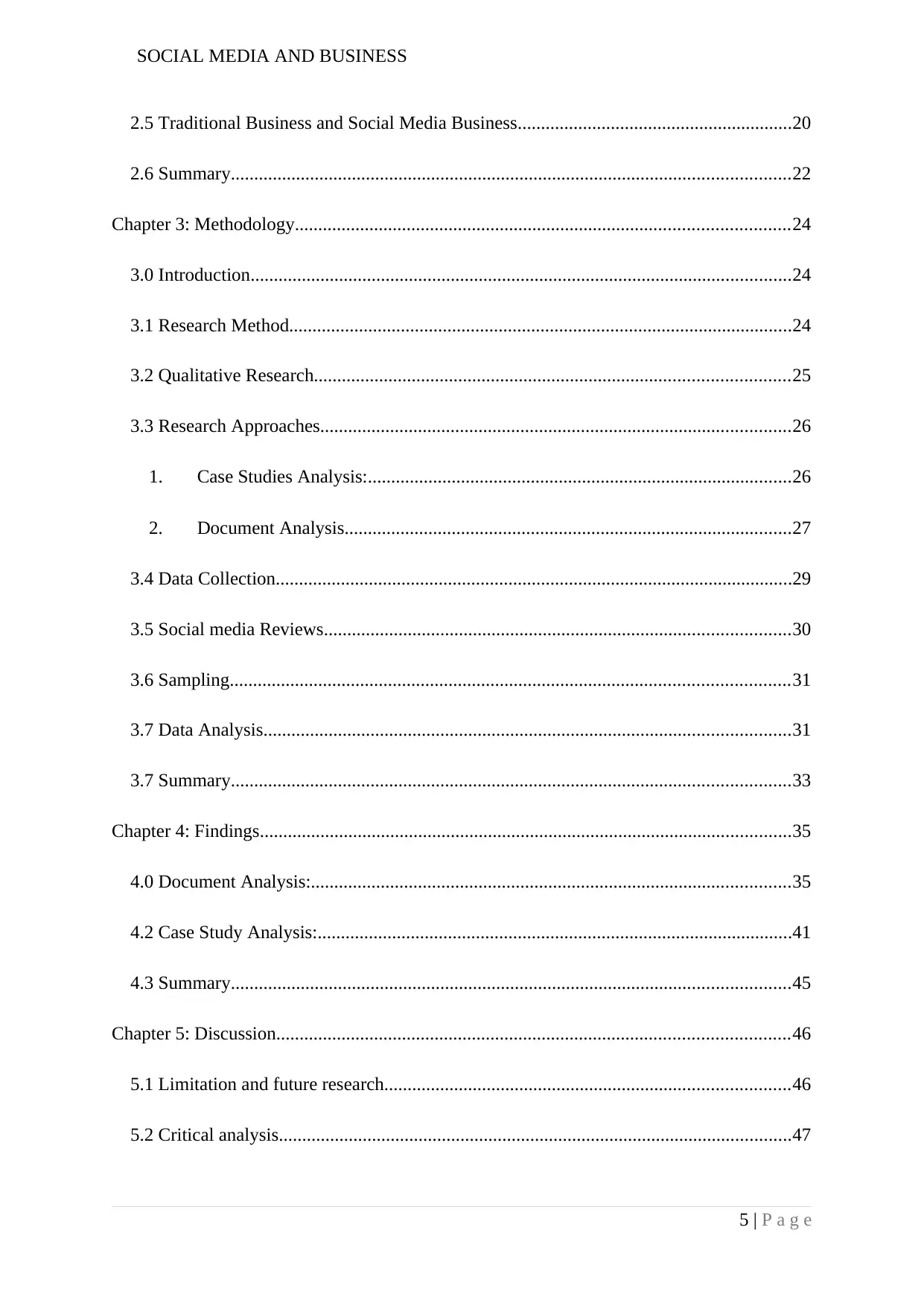
SOCIAL MEDIA AND BUSINESS
2.5 Traditional Business and Social Media Business...........................................................20
2.6 Summary........................................................................................................................22
Chapter 3: Methodology..........................................................................................................24
3.0 Introduction....................................................................................................................24
3.1 Research Method............................................................................................................24
3.2 Qualitative Research......................................................................................................25
3.3 Research Approaches.....................................................................................................26
1. Case Studies Analysis:...........................................................................................26
2. Document Analysis................................................................................................27
3.4 Data Collection...............................................................................................................29
3.5 Social media Reviews....................................................................................................30
3.6 Sampling........................................................................................................................31
3.7 Data Analysis.................................................................................................................31
3.7 Summary........................................................................................................................33
Chapter 4: Findings..................................................................................................................35
4.0 Document Analysis:.......................................................................................................35
4.2 Case Study Analysis:......................................................................................................41
4.3 Summary........................................................................................................................45
Chapter 5: Discussion..............................................................................................................46
5.1 Limitation and future research.......................................................................................46
5.2 Critical analysis..............................................................................................................47
5 | P a g e
2.5 Traditional Business and Social Media Business...........................................................20
2.6 Summary........................................................................................................................22
Chapter 3: Methodology..........................................................................................................24
3.0 Introduction....................................................................................................................24
3.1 Research Method............................................................................................................24
3.2 Qualitative Research......................................................................................................25
3.3 Research Approaches.....................................................................................................26
1. Case Studies Analysis:...........................................................................................26
2. Document Analysis................................................................................................27
3.4 Data Collection...............................................................................................................29
3.5 Social media Reviews....................................................................................................30
3.6 Sampling........................................................................................................................31
3.7 Data Analysis.................................................................................................................31
3.7 Summary........................................................................................................................33
Chapter 4: Findings..................................................................................................................35
4.0 Document Analysis:.......................................................................................................35
4.2 Case Study Analysis:......................................................................................................41
4.3 Summary........................................................................................................................45
Chapter 5: Discussion..............................................................................................................46
5.1 Limitation and future research.......................................................................................46
5.2 Critical analysis..............................................................................................................47
5 | P a g e
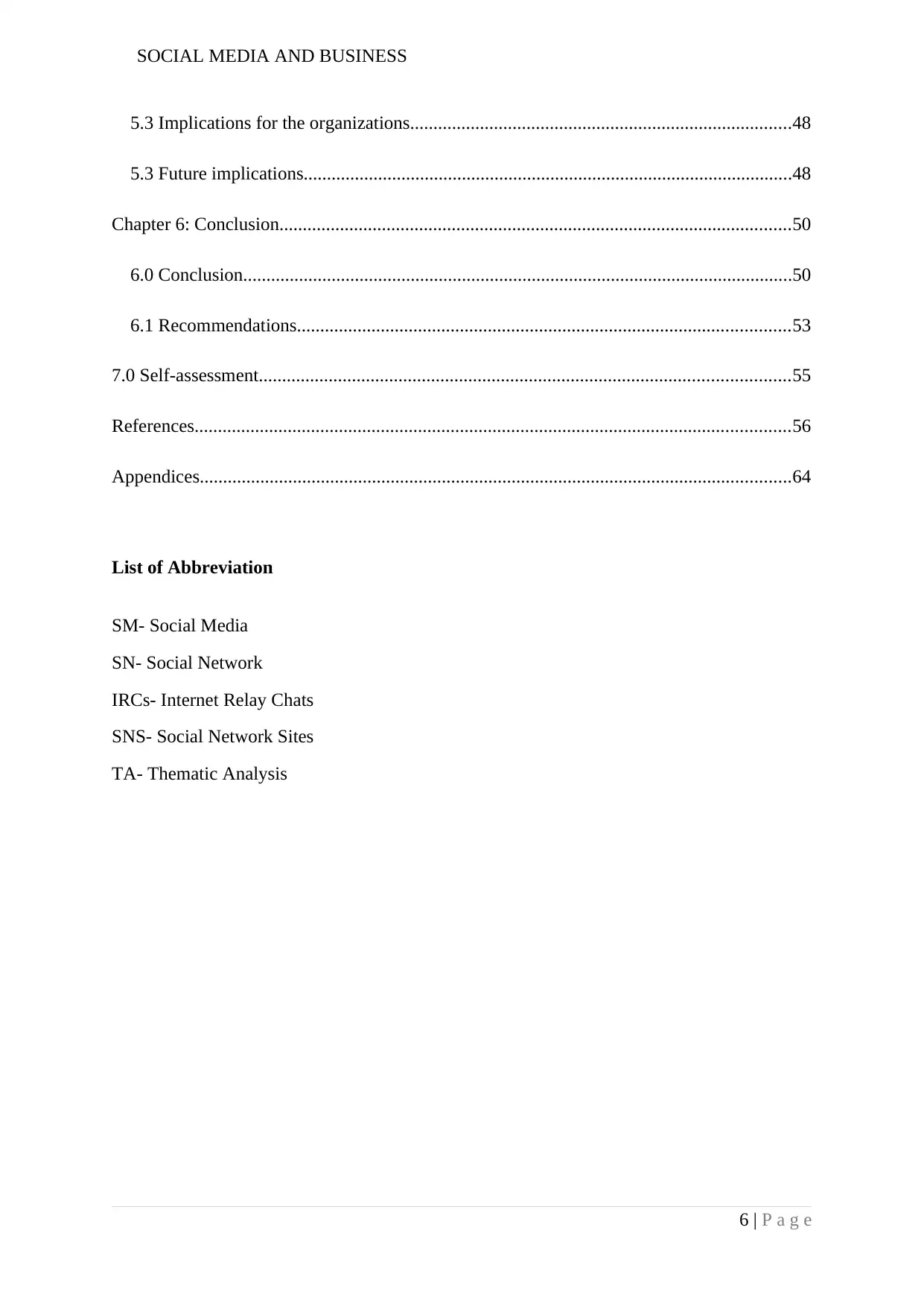
SOCIAL MEDIA AND BUSINESS
5.3 Implications for the organizations..................................................................................48
5.3 Future implications.........................................................................................................48
Chapter 6: Conclusion..............................................................................................................50
6.0 Conclusion......................................................................................................................50
6.1 Recommendations..........................................................................................................53
7.0 Self-assessment..................................................................................................................55
References................................................................................................................................56
Appendices...............................................................................................................................64
List of Abbreviation
SM- Social Media
SN- Social Network
IRCs- Internet Relay Chats
SNS- Social Network Sites
TA- Thematic Analysis
6 | P a g e
5.3 Implications for the organizations..................................................................................48
5.3 Future implications.........................................................................................................48
Chapter 6: Conclusion..............................................................................................................50
6.0 Conclusion......................................................................................................................50
6.1 Recommendations..........................................................................................................53
7.0 Self-assessment..................................................................................................................55
References................................................................................................................................56
Appendices...............................................................................................................................64
List of Abbreviation
SM- Social Media
SN- Social Network
IRCs- Internet Relay Chats
SNS- Social Network Sites
TA- Thematic Analysis
6 | P a g e
⊘ This is a preview!⊘
Do you want full access?
Subscribe today to unlock all pages.

Trusted by 1+ million students worldwide
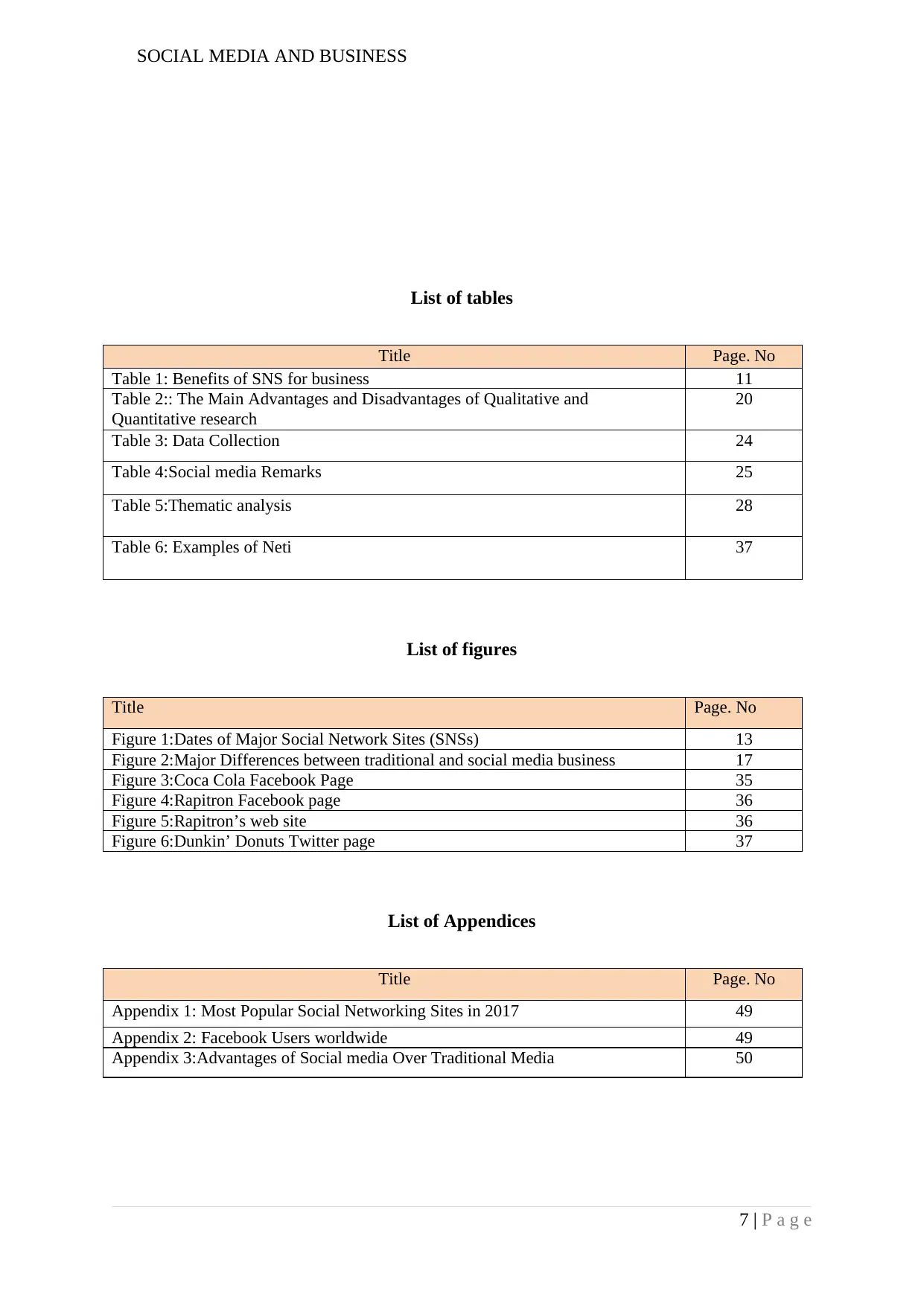
SOCIAL MEDIA AND BUSINESS
List of tables
Title Page. No
Table 1: Benefits of SNS for business 11
Table 2:: The Main Advantages and Disadvantages of Qualitative and
Quantitative research
20
Table 3: Data Collection 24
Table 4:Social media Remarks 25
Table 5:Thematic analysis 28
Table 6: Examples of Neti 37
List of figures
Title Page. No
Figure 1:Dates of Major Social Network Sites (SNSs) 13
Figure 2:Major Differences between traditional and social media business 17
Figure 3:Coca Cola Facebook Page 35
Figure 4:Rapitron Facebook page 36
Figure 5:Rapitron’s web site 36
Figure 6:Dunkin’ Donuts Twitter page 37
List of Appendices
Title Page. No
Appendix 1: Most Popular Social Networking Sites in 2017 49
Appendix 2: Facebook Users worldwide 49
Appendix 3:Advantages of Social media Over Traditional Media 50
7 | P a g e
List of tables
Title Page. No
Table 1: Benefits of SNS for business 11
Table 2:: The Main Advantages and Disadvantages of Qualitative and
Quantitative research
20
Table 3: Data Collection 24
Table 4:Social media Remarks 25
Table 5:Thematic analysis 28
Table 6: Examples of Neti 37
List of figures
Title Page. No
Figure 1:Dates of Major Social Network Sites (SNSs) 13
Figure 2:Major Differences between traditional and social media business 17
Figure 3:Coca Cola Facebook Page 35
Figure 4:Rapitron Facebook page 36
Figure 5:Rapitron’s web site 36
Figure 6:Dunkin’ Donuts Twitter page 37
List of Appendices
Title Page. No
Appendix 1: Most Popular Social Networking Sites in 2017 49
Appendix 2: Facebook Users worldwide 49
Appendix 3:Advantages of Social media Over Traditional Media 50
7 | P a g e
Paraphrase This Document
Need a fresh take? Get an instant paraphrase of this document with our AI Paraphraser
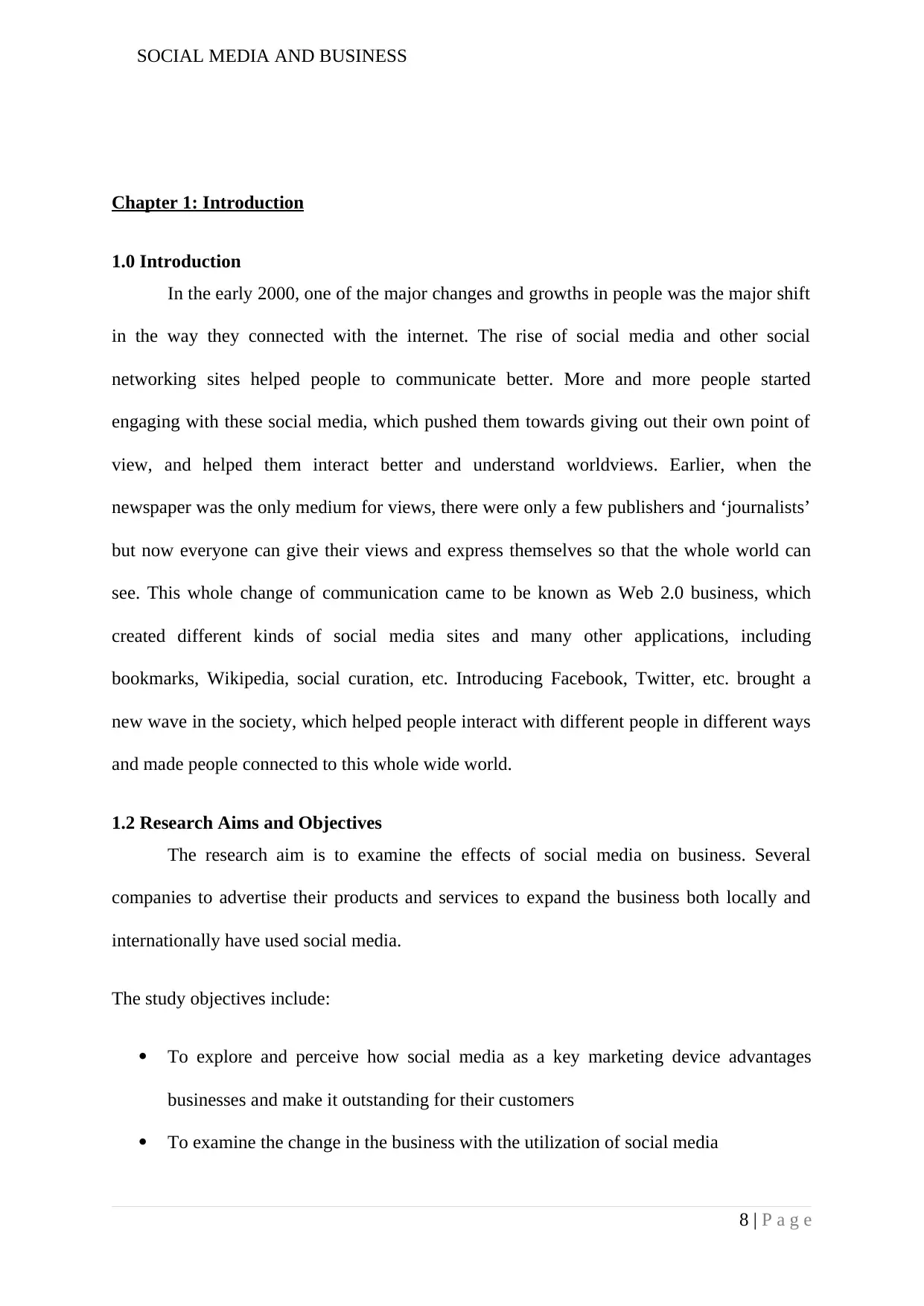
SOCIAL MEDIA AND BUSINESS
Chapter 1: Introduction
1.0 Introduction
In the early 2000, one of the major changes and growths in people was the major shift
in the way they connected with the internet. The rise of social media and other social
networking sites helped people to communicate better. More and more people started
engaging with these social media, which pushed them towards giving out their own point of
view, and helped them interact better and understand worldviews. Earlier, when the
newspaper was the only medium for views, there were only a few publishers and ‘journalists’
but now everyone can give their views and express themselves so that the whole world can
see. This whole change of communication came to be known as Web 2.0 business, which
created different kinds of social media sites and many other applications, including
bookmarks, Wikipedia, social curation, etc. Introducing Facebook, Twitter, etc. brought a
new wave in the society, which helped people interact with different people in different ways
and made people connected to this whole wide world.
1.2 Research Aims and Objectives
The research aim is to examine the effects of social media on business. Several
companies to advertise their products and services to expand the business both locally and
internationally have used social media.
The study objectives include:
To explore and perceive how social media as a key marketing device advantages
businesses and make it outstanding for their customers
To examine the change in the business with the utilization of social media
8 | P a g e
Chapter 1: Introduction
1.0 Introduction
In the early 2000, one of the major changes and growths in people was the major shift
in the way they connected with the internet. The rise of social media and other social
networking sites helped people to communicate better. More and more people started
engaging with these social media, which pushed them towards giving out their own point of
view, and helped them interact better and understand worldviews. Earlier, when the
newspaper was the only medium for views, there were only a few publishers and ‘journalists’
but now everyone can give their views and express themselves so that the whole world can
see. This whole change of communication came to be known as Web 2.0 business, which
created different kinds of social media sites and many other applications, including
bookmarks, Wikipedia, social curation, etc. Introducing Facebook, Twitter, etc. brought a
new wave in the society, which helped people interact with different people in different ways
and made people connected to this whole wide world.
1.2 Research Aims and Objectives
The research aim is to examine the effects of social media on business. Several
companies to advertise their products and services to expand the business both locally and
internationally have used social media.
The study objectives include:
To explore and perceive how social media as a key marketing device advantages
businesses and make it outstanding for their customers
To examine the change in the business with the utilization of social media
8 | P a g e
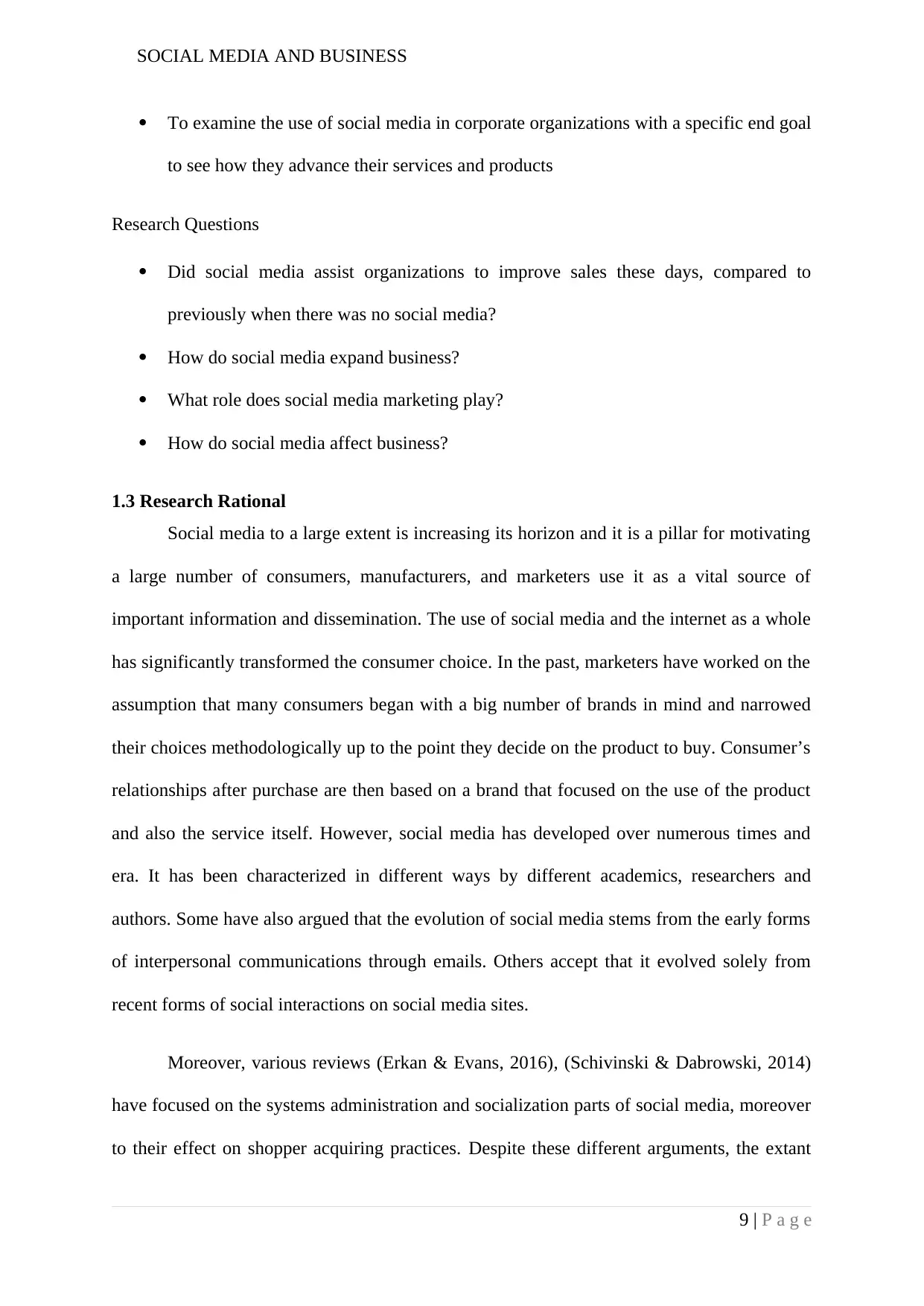
SOCIAL MEDIA AND BUSINESS
To examine the use of social media in corporate organizations with a specific end goal
to see how they advance their services and products
Research Questions
Did social media assist organizations to improve sales these days, compared to
previously when there was no social media?
How do social media expand business?
What role does social media marketing play?
How do social media affect business?
1.3 Research Rational
Social media to a large extent is increasing its horizon and it is a pillar for motivating
a large number of consumers, manufacturers, and marketers use it as a vital source of
important information and dissemination. The use of social media and the internet as a whole
has significantly transformed the consumer choice. In the past, marketers have worked on the
assumption that many consumers began with a big number of brands in mind and narrowed
their choices methodologically up to the point they decide on the product to buy. Consumer’s
relationships after purchase are then based on a brand that focused on the use of the product
and also the service itself. However, social media has developed over numerous times and
era. It has been characterized in different ways by different academics, researchers and
authors. Some have also argued that the evolution of social media stems from the early forms
of interpersonal communications through emails. Others accept that it evolved solely from
recent forms of social interactions on social media sites.
Moreover, various reviews (Erkan & Evans, 2016), (Schivinski & Dabrowski, 2014)
have focused on the systems administration and socialization parts of social media, moreover
to their effect on shopper acquiring practices. Despite these different arguments, the extant
9 | P a g e
To examine the use of social media in corporate organizations with a specific end goal
to see how they advance their services and products
Research Questions
Did social media assist organizations to improve sales these days, compared to
previously when there was no social media?
How do social media expand business?
What role does social media marketing play?
How do social media affect business?
1.3 Research Rational
Social media to a large extent is increasing its horizon and it is a pillar for motivating
a large number of consumers, manufacturers, and marketers use it as a vital source of
important information and dissemination. The use of social media and the internet as a whole
has significantly transformed the consumer choice. In the past, marketers have worked on the
assumption that many consumers began with a big number of brands in mind and narrowed
their choices methodologically up to the point they decide on the product to buy. Consumer’s
relationships after purchase are then based on a brand that focused on the use of the product
and also the service itself. However, social media has developed over numerous times and
era. It has been characterized in different ways by different academics, researchers and
authors. Some have also argued that the evolution of social media stems from the early forms
of interpersonal communications through emails. Others accept that it evolved solely from
recent forms of social interactions on social media sites.
Moreover, various reviews (Erkan & Evans, 2016), (Schivinski & Dabrowski, 2014)
have focused on the systems administration and socialization parts of social media, moreover
to their effect on shopper acquiring practices. Despite these different arguments, the extant
9 | P a g e
⊘ This is a preview!⊘
Do you want full access?
Subscribe today to unlock all pages.

Trusted by 1+ million students worldwide
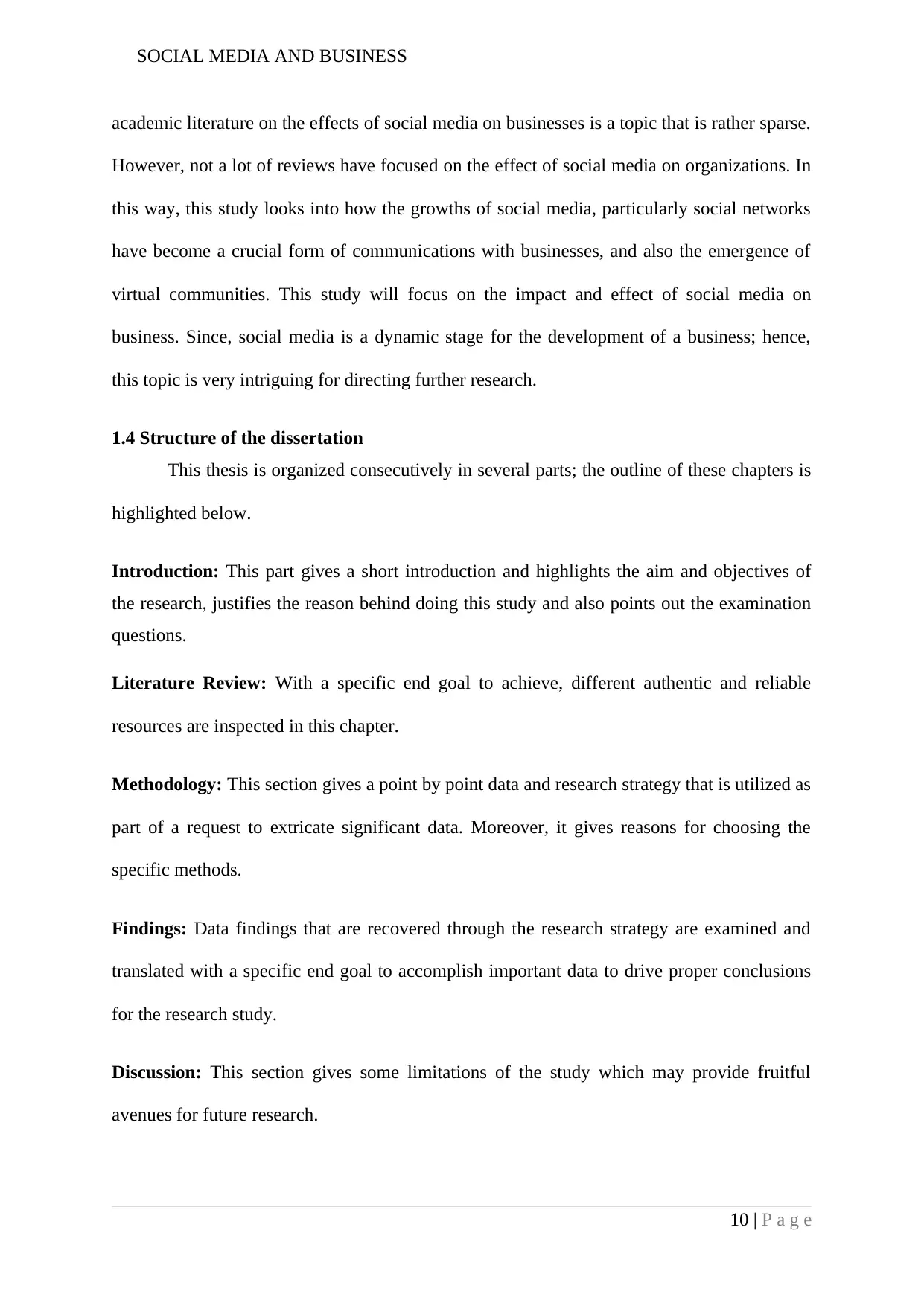
SOCIAL MEDIA AND BUSINESS
academic literature on the effects of social media on businesses is a topic that is rather sparse.
However, not a lot of reviews have focused on the effect of social media on organizations. In
this way, this study looks into how the growths of social media, particularly social networks
have become a crucial form of communications with businesses, and also the emergence of
virtual communities. This study will focus on the impact and effect of social media on
business. Since, social media is a dynamic stage for the development of a business; hence,
this topic is very intriguing for directing further research.
1.4 Structure of the dissertation
This thesis is organized consecutively in several parts; the outline of these chapters is
highlighted below.
Introduction: This part gives a short introduction and highlights the aim and objectives of
the research, justifies the reason behind doing this study and also points out the examination
questions.
Literature Review: With a specific end goal to achieve, different authentic and reliable
resources are inspected in this chapter.
Methodology: This section gives a point by point data and research strategy that is utilized as
part of a request to extricate significant data. Moreover, it gives reasons for choosing the
specific methods.
Findings: Data findings that are recovered through the research strategy are examined and
translated with a specific end goal to accomplish important data to drive proper conclusions
for the research study.
Discussion: This section gives some limitations of the study which may provide fruitful
avenues for future research.
10 | P a g e
academic literature on the effects of social media on businesses is a topic that is rather sparse.
However, not a lot of reviews have focused on the effect of social media on organizations. In
this way, this study looks into how the growths of social media, particularly social networks
have become a crucial form of communications with businesses, and also the emergence of
virtual communities. This study will focus on the impact and effect of social media on
business. Since, social media is a dynamic stage for the development of a business; hence,
this topic is very intriguing for directing further research.
1.4 Structure of the dissertation
This thesis is organized consecutively in several parts; the outline of these chapters is
highlighted below.
Introduction: This part gives a short introduction and highlights the aim and objectives of
the research, justifies the reason behind doing this study and also points out the examination
questions.
Literature Review: With a specific end goal to achieve, different authentic and reliable
resources are inspected in this chapter.
Methodology: This section gives a point by point data and research strategy that is utilized as
part of a request to extricate significant data. Moreover, it gives reasons for choosing the
specific methods.
Findings: Data findings that are recovered through the research strategy are examined and
translated with a specific end goal to accomplish important data to drive proper conclusions
for the research study.
Discussion: This section gives some limitations of the study which may provide fruitful
avenues for future research.
10 | P a g e
Paraphrase This Document
Need a fresh take? Get an instant paraphrase of this document with our AI Paraphraser
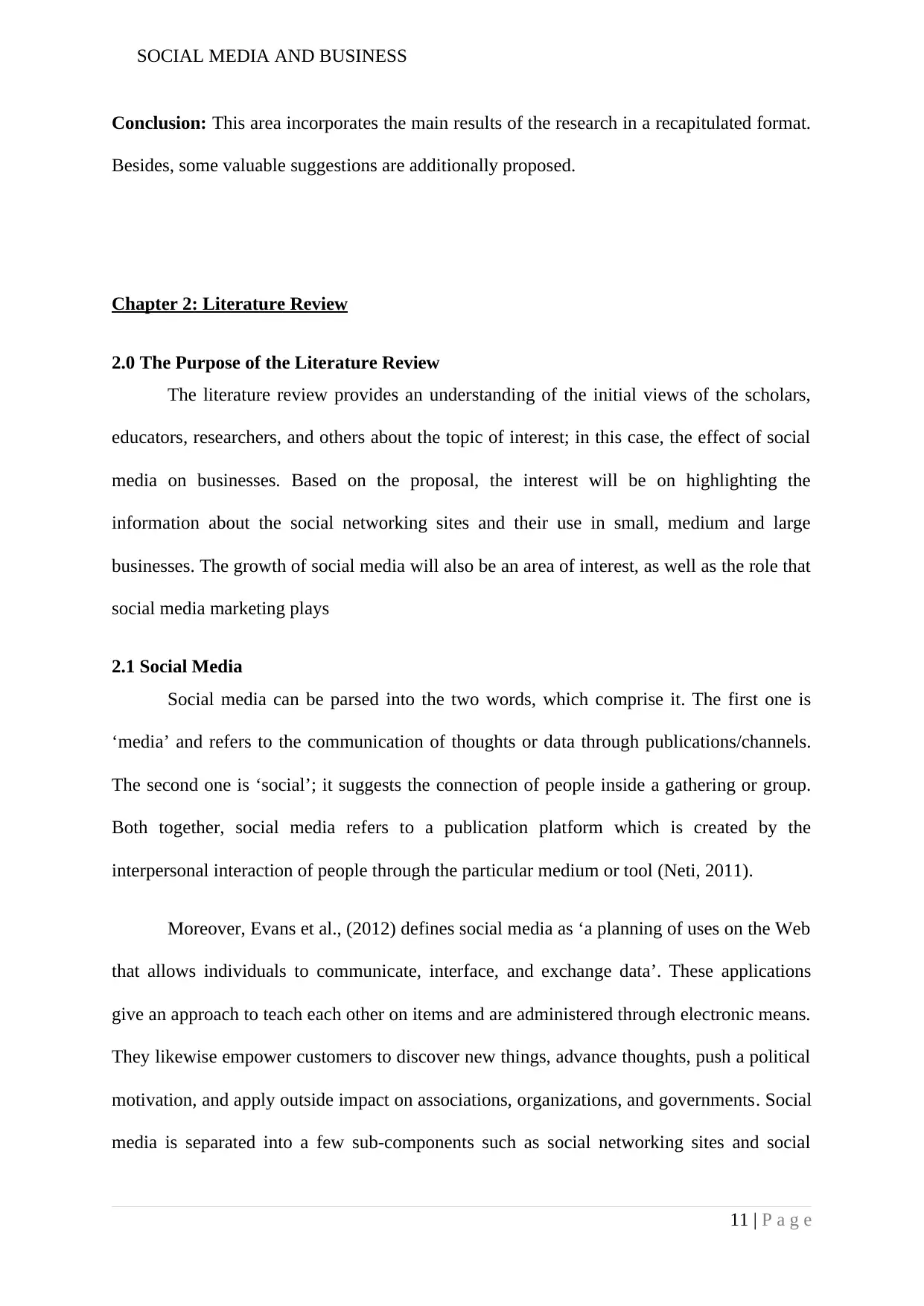
SOCIAL MEDIA AND BUSINESS
Conclusion: This area incorporates the main results of the research in a recapitulated format.
Besides, some valuable suggestions are additionally proposed.
Chapter 2: Literature Review
2.0 The Purpose of the Literature Review
The literature review provides an understanding of the initial views of the scholars,
educators, researchers, and others about the topic of interest; in this case, the effect of social
media on businesses. Based on the proposal, the interest will be on highlighting the
information about the social networking sites and their use in small, medium and large
businesses. The growth of social media will also be an area of interest, as well as the role that
social media marketing plays
2.1 Social Media
Social media can be parsed into the two words, which comprise it. The first one is
‘media’ and refers to the communication of thoughts or data through publications/channels.
The second one is ‘social’; it suggests the connection of people inside a gathering or group.
Both together, social media refers to a publication platform which is created by the
interpersonal interaction of people through the particular medium or tool (Neti, 2011).
Moreover, Evans et al., (2012) defines social media as ‘a planning of uses on the Web
that allows individuals to communicate, interface, and exchange data’. These applications
give an approach to teach each other on items and are administered through electronic means.
They likewise empower customers to discover new things, advance thoughts, push a political
motivation, and apply outside impact on associations, organizations, and governments. Social
media is separated into a few sub-components such as social networking sites and social
11 | P a g e
Conclusion: This area incorporates the main results of the research in a recapitulated format.
Besides, some valuable suggestions are additionally proposed.
Chapter 2: Literature Review
2.0 The Purpose of the Literature Review
The literature review provides an understanding of the initial views of the scholars,
educators, researchers, and others about the topic of interest; in this case, the effect of social
media on businesses. Based on the proposal, the interest will be on highlighting the
information about the social networking sites and their use in small, medium and large
businesses. The growth of social media will also be an area of interest, as well as the role that
social media marketing plays
2.1 Social Media
Social media can be parsed into the two words, which comprise it. The first one is
‘media’ and refers to the communication of thoughts or data through publications/channels.
The second one is ‘social’; it suggests the connection of people inside a gathering or group.
Both together, social media refers to a publication platform which is created by the
interpersonal interaction of people through the particular medium or tool (Neti, 2011).
Moreover, Evans et al., (2012) defines social media as ‘a planning of uses on the Web
that allows individuals to communicate, interface, and exchange data’. These applications
give an approach to teach each other on items and are administered through electronic means.
They likewise empower customers to discover new things, advance thoughts, push a political
motivation, and apply outside impact on associations, organizations, and governments. Social
media is separated into a few sub-components such as social networking sites and social
11 | P a g e
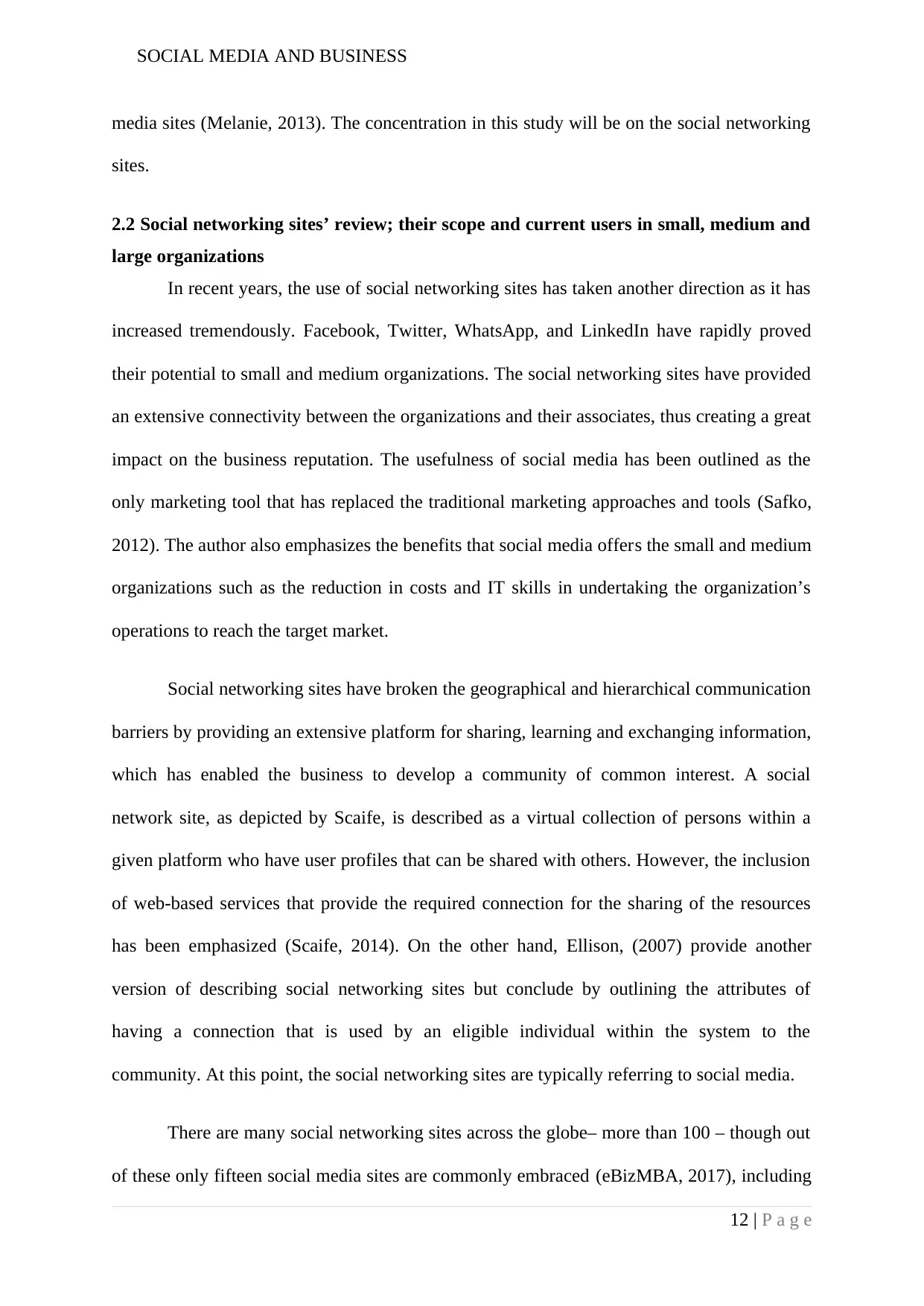
SOCIAL MEDIA AND BUSINESS
media sites (Melanie, 2013). The concentration in this study will be on the social networking
sites.
2.2 Social networking sites’ review; their scope and current users in small, medium and
large organizations
In recent years, the use of social networking sites has taken another direction as it has
increased tremendously. Facebook, Twitter, WhatsApp, and LinkedIn have rapidly proved
their potential to small and medium organizations. The social networking sites have provided
an extensive connectivity between the organizations and their associates, thus creating a great
impact on the business reputation. The usefulness of social media has been outlined as the
only marketing tool that has replaced the traditional marketing approaches and tools (Safko,
2012). The author also emphasizes the benefits that social media offers the small and medium
organizations such as the reduction in costs and IT skills in undertaking the organization’s
operations to reach the target market.
Social networking sites have broken the geographical and hierarchical communication
barriers by providing an extensive platform for sharing, learning and exchanging information,
which has enabled the business to develop a community of common interest. A social
network site, as depicted by Scaife, is described as a virtual collection of persons within a
given platform who have user profiles that can be shared with others. However, the inclusion
of web-based services that provide the required connection for the sharing of the resources
has been emphasized (Scaife, 2014). On the other hand, Ellison, (2007) provide another
version of describing social networking sites but conclude by outlining the attributes of
having a connection that is used by an eligible individual within the system to the
community. At this point, the social networking sites are typically referring to social media.
There are many social networking sites across the globe– more than 100 – though out
of these only fifteen social media sites are commonly embraced (eBizMBA, 2017), including
12 | P a g e
media sites (Melanie, 2013). The concentration in this study will be on the social networking
sites.
2.2 Social networking sites’ review; their scope and current users in small, medium and
large organizations
In recent years, the use of social networking sites has taken another direction as it has
increased tremendously. Facebook, Twitter, WhatsApp, and LinkedIn have rapidly proved
their potential to small and medium organizations. The social networking sites have provided
an extensive connectivity between the organizations and their associates, thus creating a great
impact on the business reputation. The usefulness of social media has been outlined as the
only marketing tool that has replaced the traditional marketing approaches and tools (Safko,
2012). The author also emphasizes the benefits that social media offers the small and medium
organizations such as the reduction in costs and IT skills in undertaking the organization’s
operations to reach the target market.
Social networking sites have broken the geographical and hierarchical communication
barriers by providing an extensive platform for sharing, learning and exchanging information,
which has enabled the business to develop a community of common interest. A social
network site, as depicted by Scaife, is described as a virtual collection of persons within a
given platform who have user profiles that can be shared with others. However, the inclusion
of web-based services that provide the required connection for the sharing of the resources
has been emphasized (Scaife, 2014). On the other hand, Ellison, (2007) provide another
version of describing social networking sites but conclude by outlining the attributes of
having a connection that is used by an eligible individual within the system to the
community. At this point, the social networking sites are typically referring to social media.
There are many social networking sites across the globe– more than 100 – though out
of these only fifteen social media sites are commonly embraced (eBizMBA, 2017), including
12 | P a g e
⊘ This is a preview!⊘
Do you want full access?
Subscribe today to unlock all pages.

Trusted by 1+ million students worldwide
1 out of 66
Related Documents
Your All-in-One AI-Powered Toolkit for Academic Success.
+13062052269
info@desklib.com
Available 24*7 on WhatsApp / Email
![[object Object]](/_next/static/media/star-bottom.7253800d.svg)
Unlock your academic potential
Copyright © 2020–2025 A2Z Services. All Rights Reserved. Developed and managed by ZUCOL.





